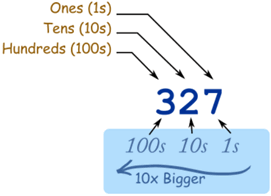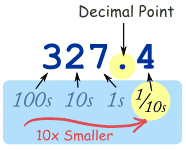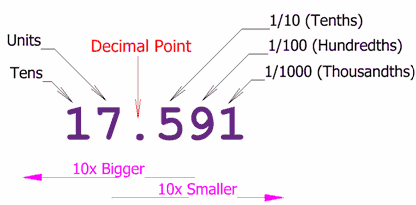A Decimal Number (based on the number 10) contains a Decimal Point.
PLACE VALUE
To understand decimal numbers you must first know about Place Value.
When we write numbers, the position (or "place") of each number is important.
In the number 327:
- the "7" is in the Units position, meaning just 7 (or 7 "1"s),
- the "2" is in the Tens position meaning 2 tens (or twenty),
- and the "3" is in the Hundreds position, meaning 3 hundreds.

| "Three Hundred Twenty Seven" |
| As we move left, each position is 10 times bigger! | |
| From Units, to Tens, to Hundreds |
... and ...
| As we move right, each position is 10 times smaller. | |
| From Hundreds, to Tens, to Units |
 |
But what if we continue past Units?
What is 10 times smaller than Units?
1/10 ths (Tenths) are!
|
| But we must first write adecimal point, so we know exactly where the Units position is: |  |
| "three hundred twenty seven and four tenths" | |
And that is a Decimal Number!
DECIMAL POINT
The decimal point is the most important part of a Decimal Number. It is exactly to the right of the Units position. Without it, we would be lost ... and not know what each position meant.
Now we can continue with smaller and smaller values, fromtenths, to hundredths, and so on, like in this example:

No comments:
Post a Comment